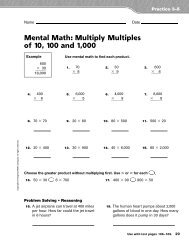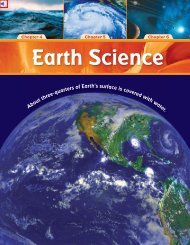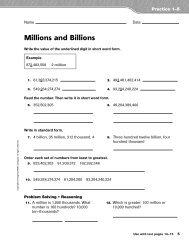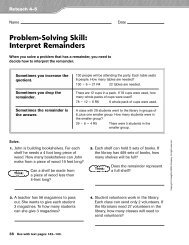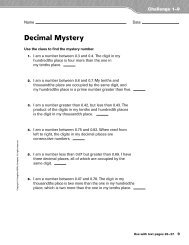Earthquake Terror Handout - Curriculum Companion
Earthquake Terror Handout - Curriculum Companion
Earthquake Terror Handout - Curriculum Companion
Create successful ePaper yourself
Turn your PDF publications into a flip-book with our unique Google optimized e-Paper software.
For Use with Houghton Mifflin<br />
5 th Grade, Theme 1, Selection 1<br />
<strong>Earthquake</strong> <strong>Terror</strong><br />
<strong>Earthquake</strong> <strong>Terror</strong><br />
BUILD BACKGROUND<br />
Theme 1, Grade 5<br />
Copyright © 2009 Sacramento County Office of Education<br />
Some images used under license from Shutterstock, Inc.<br />
California State Standards<br />
Reading<br />
• Structural Features of Informational Materials 2.1<br />
– Understand how text features (e.g., format, graphics, sequence,<br />
diagrams, illustrations, charts, maps) make information accessible<br />
and usable.<br />
• Comprehension and Analysis of Grade-Level-Appropriate<br />
Text 2.2<br />
– Use appropriate strategies when reading for different<br />
purposes (e.g., full comprehension, location of information,<br />
personal enjoyment).<br />
Copyright © 2009 Sacramento County Office of Education<br />
Some images used under license from Shutterstock, Inc.<br />
California State Standards<br />
Reading<br />
• Comprehension and Analysis of Grade-Level-Appropriate<br />
Text 2.3<br />
– Discern main ideas and concepts presented in texts, identifying<br />
and assessing evidence that supports those ideas.<br />
• Comprehension and Analysis of Grade-Level-Appropriate<br />
Text 2.4<br />
– Draw inferences, conclusions, or generalizations about text and<br />
support them with textual evidence and prior knowledge.<br />
Copyright © 2009 Sacramento County Office of Education<br />
Some images used under license from Shutterstock, Inc.<br />
<strong>Curriculum</strong> <strong>Companion</strong><br />
Sacramento County Office of Education 1
For Use with Houghton Mifflin<br />
5 th Grade, Theme 1, Selection 1<br />
<strong>Earthquake</strong> <strong>Terror</strong><br />
California State Standards<br />
Reading<br />
• Structural Features of Literature 3.1<br />
– Describe the structural differences of various imaginative<br />
forms of literature, including fantasies, fables, myths, legends, and<br />
fairy tales.<br />
• Narrative Analysis of Grade-Level-Appropriate Text 3.2<br />
– Identify the main events of the plot, their causes, and the influence<br />
of each event on future actions.<br />
Copyright © 2009 Sacramento County Office of Education<br />
Some images used under license from Shutterstock, Inc.<br />
California State Standards<br />
Reading<br />
• Narrative Analysis of Grade-Level-Appropriate Text 3.3<br />
– Use knowledge of the situation and setting and of a character’s<br />
traits and motivations to determine the causes for that<br />
character’s actions.<br />
• Literary Criticism 3.7<br />
– Evaluate the author’s use of various techniques (e.g., appeal<br />
of characters in a picture book, logic and credibility of plots<br />
and settings, use of figurative language) to influence<br />
readers’ perspectives.<br />
Copyright © 2009 Sacramento County Office of Education<br />
Some images used under license from Shutterstock, Inc.<br />
California State Standards<br />
Writing<br />
• Write responses to literature 2.2<br />
– a. Demonstrate an understanding of a literary work.<br />
Copyright © 2009 Sacramento County Office of Education<br />
Some images used under license from Shutterstock, Inc.<br />
<strong>Curriculum</strong> <strong>Companion</strong><br />
Sacramento County Office of Education 2
For Use with Houghton Mifflin<br />
5 th Grade, Theme 1, Selection 1<br />
<strong>Earthquake</strong> <strong>Terror</strong><br />
California State Standards<br />
Listening and Speaking<br />
• Deliver oral responses to literature 2.3<br />
– a. Summarize significant events and details.<br />
– b. Articulate an understanding of several ideas or images<br />
communicated by the literary work.<br />
– c. Use examples or textual evidence from the work to<br />
support conclusions.<br />
Copyright © 2009 Sacramento County Office of Education<br />
Some images used under license from Shutterstock, Inc.<br />
Connecting to the Theme<br />
“<strong>Earthquake</strong> <strong>Terror</strong>”<br />
• This theme is about the<br />
power and challenges<br />
of nature.<br />
• You have just read aloud<br />
a story about a terrible<br />
storm at sea.<br />
• What kinds of challenges<br />
might an earthquake bring?<br />
Copyright © 2009 Sacramento County Office of Education<br />
Some images used under license from Shutterstock, Inc.<br />
Connecting to the Theme<br />
“<strong>Earthquake</strong> <strong>Terror</strong>”<br />
• Volunteer to read aloud<br />
“Buildup to a Shakeup.”<br />
• Look at the map of<br />
California, the setting<br />
of the story.<br />
• Trace the San Andreas<br />
fault and discuss how<br />
it might affect the<br />
story plot.<br />
Copyright © 2009 Sacramento County Office of Education<br />
Some images used under license from Shutterstock, Inc.<br />
<strong>Curriculum</strong> <strong>Companion</strong><br />
Sacramento County Office of Education 3
For Use with Houghton Mifflin<br />
5 th Grade, Theme 1, Selection 1<br />
<strong>Earthquake</strong> <strong>Terror</strong><br />
Connecting to the Theme<br />
“<strong>Earthquake</strong> <strong>Terror</strong>”<br />
Explain the meaning of the<br />
Key Vocabulary words, and<br />
use those words as you talk<br />
about earthquake damage.<br />
Copyright © 2009 Sacramento County Office of Education<br />
Some images used under license from Shutterstock, Inc.<br />
Key Vocabulary<br />
• debris<br />
• devastation<br />
• fault<br />
• impact<br />
• jolt<br />
• shuddered<br />
• susceptible<br />
• undulating<br />
• upheaval<br />
Copyright © 2009 Sacramento County Office of Education<br />
Some images used under license from Shutterstock, Inc.<br />
debris<br />
• The office was filled<br />
with debris after the<br />
earthquake was over.<br />
• Debris is the remains<br />
of something broken<br />
or destroyed.<br />
Copyright © 2009 Sacramento County Office of Education<br />
Some images used under license from Shutterstock, Inc.<br />
<strong>Curriculum</strong> <strong>Companion</strong><br />
Sacramento County Office of Education 4
For Use with Houghton Mifflin<br />
5 th Grade, Theme 1, Selection 1<br />
<strong>Earthquake</strong> <strong>Terror</strong><br />
devastation<br />
• The great San Francisco<br />
earthquake of 1906 left<br />
the town in almost<br />
complete devastation.<br />
• Devastation is destruction<br />
or ruin.<br />
Copyright © 2009 Sacramento County Office of Education<br />
Some images used under license from Shutterstock, Inc.<br />
fault<br />
• This dark crack is only a<br />
small fault in this piece of<br />
granite that if shifted could<br />
cause an earthquake.<br />
• A fault is a break in a<br />
rock mass caused by<br />
a shifting of the earth’s<br />
crust.<br />
• The Spanish cognate<br />
of fault is falta.<br />
Copyright © 2009 Sacramento County Office of Education<br />
Some images used under license from Shutterstock, Inc.<br />
impact<br />
• The impact of the bat<br />
hitting the ball could<br />
be heard around<br />
the stadium.<br />
• An impact is the<br />
striking of one body<br />
against another.<br />
Copyright © 2009 Sacramento County Office of Education<br />
Some images used under license from Shutterstock, Inc.<br />
<strong>Curriculum</strong> <strong>Companion</strong><br />
Sacramento County Office of Education 5
For Use with Houghton Mifflin<br />
5 th Grade, Theme 1, Selection 1<br />
<strong>Earthquake</strong> <strong>Terror</strong><br />
jolt<br />
• The subway car made<br />
a jolt as it came to<br />
the station.<br />
• A jolt is a sudden<br />
jerk or bump.<br />
Copyright © 2009 Sacramento County Office of Education<br />
Some images used under license from Shutterstock, Inc.<br />
shuddered<br />
• The old house shuddered<br />
during the violent earthquake.<br />
• Shuddered is to have shook,<br />
vibrated, or quivered.<br />
Copyright © 2009 Sacramento County Office of Education<br />
Some images used under license from Shutterstock, Inc.<br />
susceptible<br />
• Some patients are<br />
susceptible to infections<br />
while staying in the hospital.<br />
• Susceptible is easily affected.<br />
Copyright © 2009 Sacramento County Office of Education<br />
Some images used under license from Shutterstock, Inc.<br />
<strong>Curriculum</strong> <strong>Companion</strong><br />
Sacramento County Office of Education 6
For Use with Houghton Mifflin<br />
5 th Grade, Theme 1, Selection 1<br />
<strong>Earthquake</strong> <strong>Terror</strong><br />
undulating<br />
• The tide was undulating,<br />
creating waves on the shore.<br />
• Undulating is moving in<br />
waves or with a smooth,<br />
wavy motion.<br />
Copyright © 2009 Sacramento County Office of Education<br />
Some images used under license from Shutterstock, Inc.<br />
upheaval<br />
• This landscape is an<br />
example of an upheaval<br />
of the earth’s crust that<br />
happened a very long<br />
time ago.<br />
• An upheaval is a lifting or<br />
upward movement of the<br />
earth’s crust.<br />
Copyright © 2009 Sacramento County Office of Education<br />
Some images used under license from Shutterstock, Inc.<br />
Strategy Focus: Predict/Infer<br />
“<strong>Earthquake</strong> <strong>Terror</strong>”<br />
• Turn to page 28 and read<br />
the title and author of the<br />
selection.<br />
• Read the Strategy Focus.<br />
• Read the introduction on<br />
page 29 and think about the<br />
Strategy Focus question.<br />
• What predictions do you<br />
have for this story?<br />
Copyright © 2009 Sacramento County Office of Education<br />
Some images used under license from Shutterstock, Inc.<br />
<strong>Curriculum</strong> <strong>Companion</strong><br />
Sacramento County Office of Education 7
For Use with Houghton Mifflin<br />
5 th Grade, Theme 1, Selection 1<br />
<strong>Earthquake</strong> <strong>Terror</strong><br />
Sequence of Events<br />
“<strong>Earthquake</strong> <strong>Terror</strong>”<br />
• You will focus on the<br />
sequence of events,<br />
or the order of the<br />
story events, in<br />
“<strong>Earthquake</strong> <strong>Terror</strong>.”<br />
• To develop this skill, you<br />
will record the main story<br />
events in the order they<br />
occur on an event map<br />
from your Practice Book.<br />
Copyright © 2009 Sacramento County Office of Education<br />
Some images used under license from Shutterstock, Inc.<br />
Focus Questions<br />
“<strong>Earthquake</strong> <strong>Terror</strong>”<br />
• Turn to Responding<br />
on page 46.<br />
• Read the questions.<br />
• Keep these questions<br />
in mind as you read<br />
“<strong>Earthquake</strong> <strong>Terror</strong>.”<br />
Copyright © 2009 Sacramento County Office of Education<br />
Some images used under license from Shutterstock, Inc.<br />
Purpose Setting<br />
“<strong>Earthquake</strong> <strong>Terror</strong>”<br />
• Recall the predictions<br />
you made for the Strategy<br />
Focus on Anthology page 28.<br />
• Read to confirm or<br />
change your predictions<br />
as the story unfolds.<br />
Copyright © 2009 Sacramento County Office of Education<br />
Some images used under license from Shutterstock, Inc.<br />
<strong>Curriculum</strong> <strong>Companion</strong><br />
Sacramento County Office of Education 8
For Use with Houghton Mifflin<br />
5 th Grade, Theme 1, Selection 1<br />
<strong>Earthquake</strong> <strong>Terror</strong><br />
Supporting Comprehension<br />
“<strong>Earthquake</strong> <strong>Terror</strong>”<br />
• What do Jonathan’s<br />
thoughts of home<br />
tell you about his<br />
present situation?<br />
• What does the author<br />
mean by the passage<br />
that begins “Time had a<br />
way of evaporating…?”<br />
Copyright © 2009 Sacramento County Office of Education<br />
Some images used under license from Shutterstock, Inc.<br />
Supporting Comprehension<br />
“<strong>Earthquake</strong> <strong>Terror</strong>”<br />
How does the author<br />
reveal Jonathan’s<br />
feelings about Abby?<br />
Copyright © 2009 Sacramento County Office of Education<br />
Some images used under license from Shutterstock, Inc.<br />
Realistic Fiction<br />
“<strong>Earthquake</strong> <strong>Terror</strong>”<br />
The characteristics of realistic fiction are:<br />
– The story problem and solution are realistic.<br />
– Story events could happen in real life, even though the<br />
author created them.<br />
– The story characters speak, think, feel, and act as real<br />
people do and have the same problems real people<br />
might have.<br />
Copyright © 2009 Sacramento County Office of Education<br />
Some images used under license from Shutterstock, Inc.<br />
<strong>Curriculum</strong> <strong>Companion</strong><br />
Sacramento County Office of Education 9
For Use with Houghton Mifflin<br />
5 th Grade, Theme 1, Selection 1<br />
<strong>Earthquake</strong> <strong>Terror</strong><br />
Realistic Fiction<br />
“<strong>Earthquake</strong> <strong>Terror</strong>”<br />
• Jonathan’s worries about<br />
being far from neighbors and<br />
a phone make him seem like<br />
a real person.<br />
• Identify other details that<br />
make “<strong>Earthquake</strong> <strong>Terror</strong>”<br />
a piece of realistic fiction.<br />
Copyright © 2009 Sacramento County Office of Education<br />
Some images used under license from Shutterstock, Inc.<br />
Realistic Fiction<br />
“<strong>Earthquake</strong> <strong>Terror</strong>”<br />
• In small groups, create a<br />
chart showing examples<br />
of how Jonathan behaves<br />
like a real person.<br />
• Compare your work with<br />
other groups when you<br />
are finished.<br />
Copyright © 2009 Sacramento County Office of Education<br />
Some images used under license from Shutterstock, Inc.<br />
Realistic Fiction<br />
“<strong>Earthquake</strong> <strong>Terror</strong>”<br />
Download this graphic organizer at www.curriculumcompanion.org<br />
Copyright © 2009 Sacramento County Office of Education<br />
Some images used under license from Shutterstock, Inc.<br />
<strong>Curriculum</strong> <strong>Companion</strong><br />
Sacramento County Office of Education 10
For Use with Houghton Mifflin<br />
5 th Grade, Theme 1, Selection 1<br />
<strong>Earthquake</strong> <strong>Terror</strong><br />
Strategy Focus: Predict/Infer<br />
“<strong>Earthquake</strong> <strong>Terror</strong>”<br />
• Discuss clues on page 32<br />
that can help you predict<br />
that trouble is on the way.<br />
• What predictions can you<br />
make from these sentences?<br />
– “Jonathan listened. He heard<br />
a deep rumbling sound in the<br />
distance…Hunters! he thought.”<br />
Copyright © 2009 Sacramento County Office of Education<br />
Some images used under license from Shutterstock, Inc.<br />
Supporting Comprehension<br />
“<strong>Earthquake</strong> <strong>Terror</strong>”<br />
Why does the author<br />
say that Jonathan<br />
“felt as if he were on<br />
a surfboard…?”<br />
Copyright © 2009 Sacramento County Office of Education<br />
Some images used under license from Shutterstock, Inc.<br />
Cross-Curricular Connection: Science<br />
“<strong>Earthquake</strong> <strong>Terror</strong>”<br />
• Dogs howl; snakes leave their<br />
burrows; zoo animals refuse to<br />
go inside – for centuries people<br />
have reported unusual animal<br />
behavior before earthquakes.<br />
• Scientists think changes to<br />
the earth’s crust before a<br />
quake create sudden<br />
changes in sound vibrations<br />
or electro-magnetic fields,<br />
which act as danger signals<br />
to many creatures.<br />
Copyright © 2009 Sacramento County Office of Education<br />
Some images used under license from Shutterstock, Inc.<br />
<strong>Curriculum</strong> <strong>Companion</strong><br />
Sacramento County Office of Education 11
For Use with Houghton Mifflin<br />
5 th Grade, Theme 1, Selection 1<br />
<strong>Earthquake</strong> <strong>Terror</strong><br />
Sequence of Events<br />
“<strong>Earthquake</strong> <strong>Terror</strong>”<br />
• The sequence of events on<br />
page 32 are:<br />
– First Jonathan noticed<br />
how quiet it was, and then<br />
Moose barked.<br />
• The words first and<br />
then signal when each event<br />
happened.<br />
Copyright © 2009 Sacramento County Office of Education<br />
Some images used under license from Shutterstock, Inc.<br />
Sequence of Events<br />
“<strong>Earthquake</strong> <strong>Terror</strong>”<br />
• Name other story<br />
events from pages 32<br />
and 33 and list them in<br />
order on the board.<br />
• Note any words used<br />
to signal sequence.<br />
Copyright © 2009 Sacramento County Office of Education<br />
Some images used under license from Shutterstock, Inc.<br />
Sequence of Events<br />
“<strong>Earthquake</strong> <strong>Terror</strong>”<br />
• Sometimes two or more<br />
story events happen at<br />
the same time.<br />
• Read the first sentence<br />
on page 32.<br />
• The word while signals<br />
that two events happen at<br />
the same time; they walked<br />
and Jonathan planned.<br />
Copyright © 2009 Sacramento County Office of Education<br />
Some images used under license from Shutterstock, Inc.<br />
<strong>Curriculum</strong> <strong>Companion</strong><br />
Sacramento County Office of Education 12
For Use with Houghton Mifflin<br />
5 th Grade, Theme 1, Selection 1<br />
<strong>Earthquake</strong> <strong>Terror</strong><br />
Sequence of Events<br />
“<strong>Earthquake</strong> <strong>Terror</strong>”<br />
• Identify simultaneous<br />
events in the second<br />
paragraph on page 22<br />
and the signal word.<br />
• In partners, find other<br />
story events happening<br />
at the same time.<br />
Copyright © 2009 Sacramento County Office of Education<br />
Some images used under license from Shutterstock, Inc.<br />
Supporting Comprehension<br />
“<strong>Earthquake</strong> <strong>Terror</strong>”<br />
• Why do you think the<br />
author includes Jonathan’s<br />
memories about school<br />
earthquake drills?<br />
• What does the author<br />
mean in the passage.<br />
“That was school. This<br />
was Magpie Island”?<br />
Copyright © 2009 Sacramento County Office of Education<br />
Some images used under license from Shutterstock, Inc.<br />
Comprehension/Critical Thinking<br />
“<strong>Earthquake</strong> <strong>Terror</strong>”<br />
• Using Jonathan’s<br />
experience, describe<br />
how it feels to be in an<br />
earthquake.<br />
• Will Jonathan be able to<br />
use what he learned in<br />
school earthquake drills?<br />
Explain.<br />
Copyright © 2009 Sacramento County Office of Education<br />
Some images used under license from Shutterstock, Inc.<br />
<strong>Curriculum</strong> <strong>Companion</strong><br />
Sacramento County Office of Education 13
For Use with Houghton Mifflin<br />
5 th Grade, Theme 1, Selection 1<br />
<strong>Earthquake</strong> <strong>Terror</strong><br />
<strong>Earthquake</strong> <strong>Terror</strong><br />
SEGMENT 2<br />
Copyright © 2009 Sacramento County Office of Education<br />
Some images used under license from Shutterstock, Inc.<br />
Purpose Setting<br />
“<strong>Earthquake</strong> <strong>Terror</strong>”<br />
• Summarize the story so<br />
far and predict what will<br />
happen to Jonathan and<br />
Abby.<br />
• Read pages 36-44 to<br />
check your predictions.<br />
Copyright © 2009 Sacramento County Office of Education<br />
Some images used under license from Shutterstock, Inc.<br />
Noting Details<br />
“<strong>Earthquake</strong> <strong>Terror</strong>”<br />
Details are important to a story because they<br />
help readers:<br />
– understand important information about characters<br />
and events<br />
– see, hear, and feel what the characters experience<br />
– picture the story setting and sense the mood an<br />
author creates<br />
Copyright © 2009 Sacramento County Office of Education<br />
Some images used under license from Shutterstock, Inc.<br />
<strong>Curriculum</strong> <strong>Companion</strong><br />
Sacramento County Office of Education 14
For Use with Houghton Mifflin<br />
5 th Grade, Theme 1, Selection 1<br />
<strong>Earthquake</strong> <strong>Terror</strong><br />
Noting Details<br />
“<strong>Earthquake</strong> <strong>Terror</strong>”<br />
• On page 36 the author<br />
describes what happens<br />
to Jonathan as, “After the<br />
quake pitches Jonathan into<br />
the air, he hits the ground so<br />
hard that he jars every bone<br />
in his body.”<br />
• Those words help the<br />
reader picture exactly what<br />
happens to him.<br />
Copyright © 2009 Sacramento County Office of Education<br />
Some images used under license from Shutterstock, Inc.<br />
Noting Details<br />
“<strong>Earthquake</strong> <strong>Terror</strong>”<br />
Identify other story details<br />
that help you understand<br />
the children’s terror,<br />
experience the earthquake,<br />
and visualize the setting.<br />
Copyright © 2009 Sacramento County Office of Education<br />
Some images used under license from Shutterstock, Inc.<br />
Supporting Comprehension<br />
“<strong>Earthquake</strong> <strong>Terror</strong>”<br />
• Why do you think<br />
Jonathan tells Abby,<br />
“It’s only an earthquake”?<br />
• Why do you think the<br />
author describes<br />
Jonathan’s memory<br />
about earthquakes here?<br />
Copyright © 2009 Sacramento County Office of Education<br />
Some images used under license from Shutterstock, Inc.<br />
<strong>Curriculum</strong> <strong>Companion</strong><br />
Sacramento County Office of Education 15
For Use with Houghton Mifflin<br />
5 th Grade, Theme 1, Selection 1<br />
<strong>Earthquake</strong> <strong>Terror</strong><br />
Supporting Comprehension<br />
“<strong>Earthquake</strong> <strong>Terror</strong>”<br />
Describe how the fallen<br />
tree provides shelter for<br />
Jonathan and Abby.<br />
Copyright © 2009 Sacramento County Office of Education<br />
Some images used under license from Shutterstock, Inc.<br />
Mood<br />
“<strong>Earthquake</strong> <strong>Terror</strong>”<br />
• Writers deliberately use words, details, and<br />
descriptive language to create the mood, or<br />
emotional tone, in a scene or story.<br />
• Read the following from page 38:<br />
– “Jonathan struggled toward her again, his<br />
heart racing.”<br />
– “I want Mommy!” Abby shrieked.”<br />
– “Her fingernails dug into Jonathan’s bare arm.”<br />
Copyright © 2009 Sacramento County Office of Education<br />
Some images used under license from Shutterstock, Inc.<br />
Mood<br />
“<strong>Earthquake</strong> <strong>Terror</strong>”<br />
• The words “his heart racing”<br />
and “shrieked” and the image<br />
of Abby’s nails digging into<br />
Jonathan’s arm convey a mood<br />
of fear, alarm, and panic.<br />
• Identify other scenes having<br />
a similar mood.<br />
• Name other moods an author<br />
may want to create.<br />
Copyright © 2009 Sacramento County Office of Education<br />
Some images used under license from Shutterstock, Inc.<br />
<strong>Curriculum</strong> <strong>Companion</strong><br />
Sacramento County Office of Education 16
For Use with Houghton Mifflin<br />
5 th Grade, Theme 1, Selection 1<br />
<strong>Earthquake</strong> <strong>Terror</strong><br />
Supporting Comprehension<br />
“<strong>Earthquake</strong> <strong>Terror</strong>”<br />
• What does the sentence<br />
“Anxiety tied a tight knot in<br />
Jonathan’s stomach” say about<br />
Jonathan’s situation?<br />
• What does the author mean<br />
by “the silence seemed both<br />
comforting and ominous”?<br />
• Why do you think the author<br />
includes Jonathan’s memory<br />
of Grandma Whitney?<br />
Copyright © 2009 Sacramento County Office of Education<br />
Some images used under license from Shutterstock, Inc.<br />
Strategy Focus: Predict/Infer<br />
“<strong>Earthquake</strong> <strong>Terror</strong>”<br />
• Model your predictions<br />
about what Jonathan<br />
and Abby will do after the<br />
quake stops.<br />
• Based on Jonathan’s<br />
actions and decisions so<br />
far, what might he need<br />
to do to get Abby and<br />
himself to safety?<br />
Copyright © 2009 Sacramento County Office of Education<br />
Some images used under license from Shutterstock, Inc.<br />
Supporting Comprehension<br />
“<strong>Earthquake</strong> <strong>Terror</strong>”<br />
Why do you think the<br />
author includes Jonathan’s<br />
memories of Moose?<br />
Copyright © 2009 Sacramento County Office of Education<br />
Some images used under license from Shutterstock, Inc.<br />
<strong>Curriculum</strong> <strong>Companion</strong><br />
Sacramento County Office of Education 17
For Use with Houghton Mifflin<br />
5 th Grade, Theme 1, Selection 1<br />
<strong>Earthquake</strong> <strong>Terror</strong><br />
Cross-Curricular Connection<br />
“<strong>Earthquake</strong> <strong>Terror</strong>”<br />
• Since the 1940’s, scientists and engineers have<br />
been studying earthquakes to improve the way<br />
buildings are constructed.<br />
• Today, sophisticated instruments in houses,<br />
highways, schools, hospitals, and bridges<br />
measure how well these structures tolerate<br />
each tremor.<br />
• Their objective is to reduce the loss of life and<br />
property damage.<br />
Copyright © 2009 Sacramento County Office of Education<br />
Some images used under license from Shutterstock, Inc.<br />
Story Structure<br />
“<strong>Earthquake</strong> <strong>Terror</strong>”<br />
• The five elements of<br />
a story are the setting,<br />
characters, problem,<br />
main events, and outcome.<br />
• Together these parts make<br />
up the structure of a story.<br />
Copyright © 2009 Sacramento County Office of Education<br />
Some images used under license from Shutterstock, Inc.<br />
Story Structure<br />
“<strong>Earthquake</strong> <strong>Terror</strong>”<br />
• Look at the words woods<br />
and island and other details<br />
from page 29 that provide<br />
clues about the setting of<br />
“<strong>Earthquake</strong> <strong>Terror</strong>.”<br />
• Use the story map on the<br />
next slide to give story<br />
details.<br />
Copyright © 2009 Sacramento County Office of Education<br />
Some images used under license from Shutterstock, Inc.<br />
<strong>Curriculum</strong> <strong>Companion</strong><br />
Sacramento County Office of Education 18
For Use with Houghton Mifflin<br />
5 th Grade, Theme 1, Selection 1<br />
<strong>Earthquake</strong> <strong>Terror</strong><br />
Story Structure<br />
“<strong>Earthquake</strong> <strong>Terror</strong>”<br />
Download this graphic organizer at www.curriculumcompanion.org<br />
Copyright © 2009 Sacramento County Office of Education<br />
Some images used under license from Shutterstock, Inc.<br />
Supporting Comprehension<br />
“<strong>Earthquake</strong> <strong>Terror</strong>”<br />
• What does the author<br />
mean by saying that<br />
Abby will get upset if<br />
Jonathan makes a fuss<br />
about her cut?<br />
• How has the author<br />
solved the story problem<br />
for Jonathan and Abby?<br />
• What new problems do<br />
they face?<br />
Copyright © 2009 Sacramento County Office of Education<br />
Some images used under license from Shutterstock, Inc.<br />
Comprehension/Critical Thinking<br />
“<strong>Earthquake</strong> <strong>Terror</strong>”<br />
• In your opinion, is it a<br />
good idea for Jonathan<br />
to take Abby and crawl<br />
under the redwood<br />
tree? Explain.<br />
• How do Jonathan’s<br />
memories help him<br />
during the earthquake?<br />
Copyright © 2009 Sacramento County Office of Education<br />
Some images used under license from Shutterstock, Inc.<br />
<strong>Curriculum</strong> <strong>Companion</strong><br />
Sacramento County Office of Education 19



